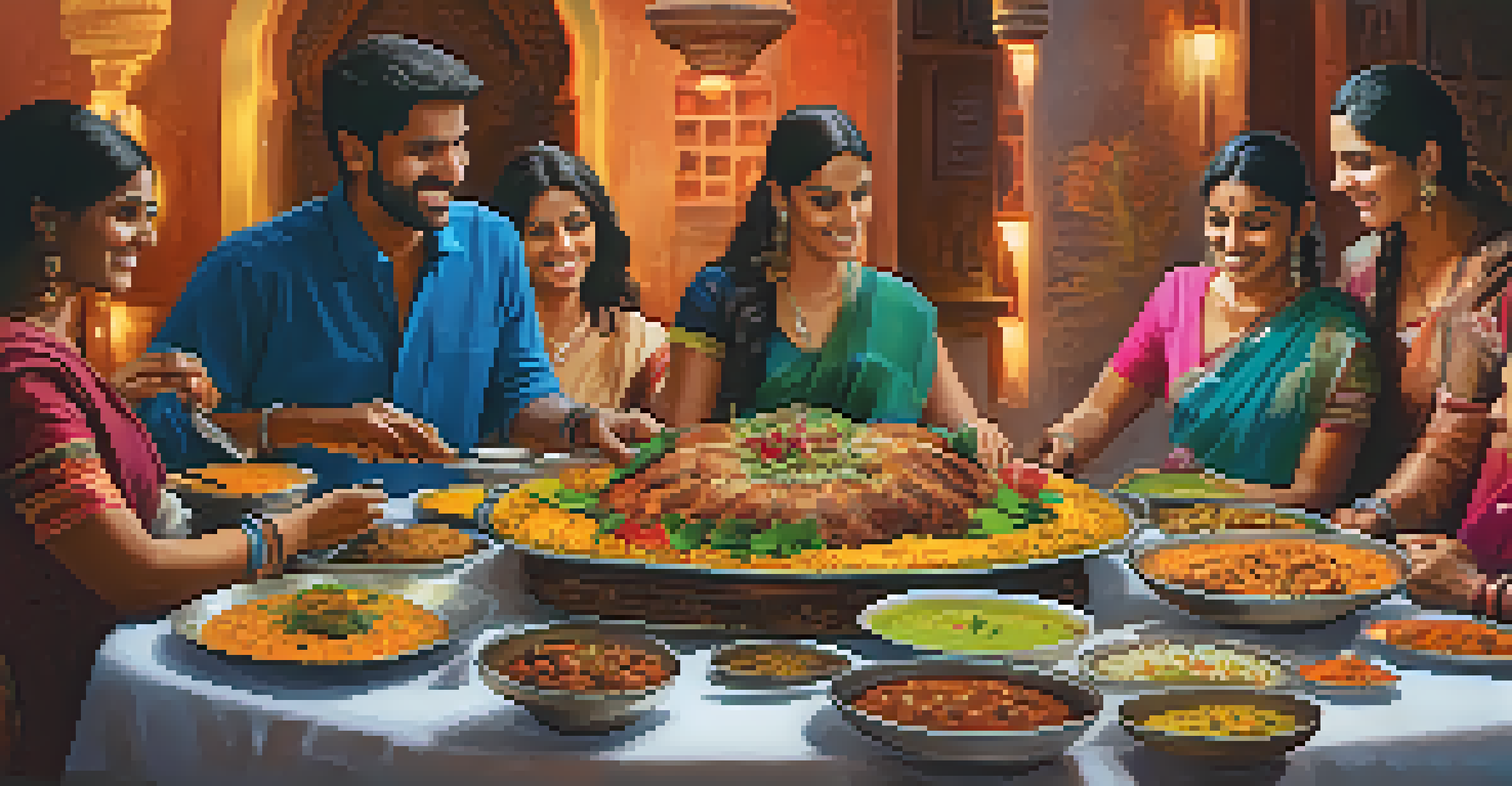Dining Etiquette Around the World: A Traveler’s Guide

Understanding the Importance of Dining Etiquette
Dining etiquette is more than just table manners; it’s a reflection of cultural values and respect for traditions. Whether it's a formal dinner or a casual meal, understanding these customs can enhance your travel experience. Good etiquette can help you connect with locals and show appreciation for their culture.
Food is our common ground, a universal experience.
For example, in Japan, the act of saying 'Itadakimasu' before meals expresses gratitude for the food. This simple phrase sets the tone for a respectful dining experience. Similarly, in many Middle Eastern cultures, sharing food is a sign of hospitality and friendship.
Being aware of these nuances can prevent cultural faux pas and make your dining experience more enjoyable. So, let’s dive into some specific dining customs from around the globe!
Dining Etiquette in Japan: A Unique Experience
In Japan, dining is an art form, and there are specific customs to follow. It’s polite to bow slightly before sitting down and to use chopsticks correctly—never stick them upright in rice, as this resembles a funeral ritual. Additionally, slurping your noodles is not only acceptable but encouraged as it shows enjoyment of the meal.

Another important aspect is the concept of 'omotenashi,' which means selfless hospitality. Hosts often go above and beyond to ensure guests feel comfortable, highlighting the importance of gratitude in this culture. Saying 'Arigatou gozaimasu' after a meal is a nice touch to express your appreciation.
Dining Etiquette Reflects Culture
Understanding dining etiquette enhances your travel experiences by showing respect for local customs.
By embracing these customs, you’ll not only enjoy your meal more but also leave a lasting positive impression on your Japanese hosts. Remember, it’s about respect and connection through food!
Dining Customs in Italy: More than Just Food
In Italy, dining is a social event, and meals often stretch for hours as families and friends gather around the table. One key rule is that it's considered rude to ask for a substitution in a dish, as it undermines the chef’s expertise. Instead, savor the flavors that are presented to you!
Dining is and always was a great artistic opportunity.
When it comes to ordering, Italians typically enjoy pasta as a first course, followed by a second course of meat or fish. Don't be surprised if you see locals enjoying their cappuccino only in the morning—it's a common belief that dairy should not mix with meals later in the day.
So, when dining in Italy, embrace the slow pace and focus on the experience. It’s all about enjoying the company and the food, making it a delightful affair!
Dining Etiquette in India: Embrace the Spice
Dining in India is as diverse as its culture, with various customs depending on the region. One common practice is eating with your hands, which is not only traditional but also considered a way to connect with your food. It’s important to use your right hand only, as the left hand is deemed unclean.
Before starting a meal, it’s customary to wash your hands, sometimes even before and after each course. Additionally, if you’re invited to someone’s home, bringing a small gift, like sweets or flowers, is a lovely gesture of appreciation.
Communal Dining Fosters Connections
Participating in communal dining practices deepens relationships and shows appreciation for the host's efforts.
By understanding these dining practices, you can fully immerse yourself in the rich culinary landscape of India, making your meals both delicious and meaningful.
Dining Etiquette in France: The Language of Food
In France, dining is a theatrical experience. From the way food is presented to the fine art of conversation, every aspect is crucial. One important etiquette tip is to keep your hands on the table (but not your elbows), as this conveys engagement with the meal and company.
When it comes to bread, it’s common to place it directly on the table instead of on your plate. Additionally, remember to wait for the host to start the meal before digging in, as this shows respect for their role. And, of course, enjoying a glass of wine is a must, but be sure to sip slowly and appreciate the flavors.
Dining in France is about the experience as much as the food. Engage in conversations, relish the flavors, and you’ll feel like a true Parisian!
Dining Etiquette in China: A Communal Affair
In China, meals are often served family-style, with several dishes shared among the table. This communal approach emphasizes togetherness and is a reflection of Chinese values. When dining, it’s polite to wait for the eldest person at the table to start eating first.
Using chopsticks correctly is essential; never stick them upright in your rice, as this symbolizes death. Instead, place them neatly on the table when you're not using them. Additionally, it’s courteous to offer food to others at the table as a sign of generosity.
Embrace Local Customs While Eating
Being aware of and embracing local dining customs can transform meals into meaningful cultural experiences.
By participating in these customs, you’ll not only enjoy the food but also foster deeper connections with your dining companions. In China, every meal is an opportunity to strengthen relationships.
Dining Etiquette in the Middle East: Hospitality Rules
In many Middle Eastern cultures, hospitality is of utmost importance, and meals are often lavish affairs. When invited to someone's home, it’s customary to bring a small gift, like sweets or fruits, as a token of appreciation. When dining, it’s polite to wait for the host to begin before you start eating.
Meals are typically served on a communal platter, and it’s common to use your right hand to eat. In some cultures, it’s a sign of respect to finish all the food on your plate, as leaving food can imply that you didn’t enjoy the meal. This highlights the host’s efforts in providing a delicious spread.

By embracing these customs, you not only enjoy a meal but also honor the traditions of your hosts, making for a memorable dining experience.
Final Thoughts: Embrace Global Dining Etiquette
As you travel the world, understanding and respecting dining etiquette can transform your culinary experiences. Each culture has its own unique practices, and being aware of them shows respect and appreciation for local customs. This not only enhances your meals but also fosters connections with locals.
Whether you're slurping noodles in Japan or sharing a communal platter in the Middle East, these dining experiences are integral to understanding a culture. Remember, the essence of dining is about connection, gratitude, and enjoyment.
So, next time you sit down to eat abroad, take a moment to soak in the customs around you. You’ll find that every meal tells a story, and by participating fully, you become part of that narrative.